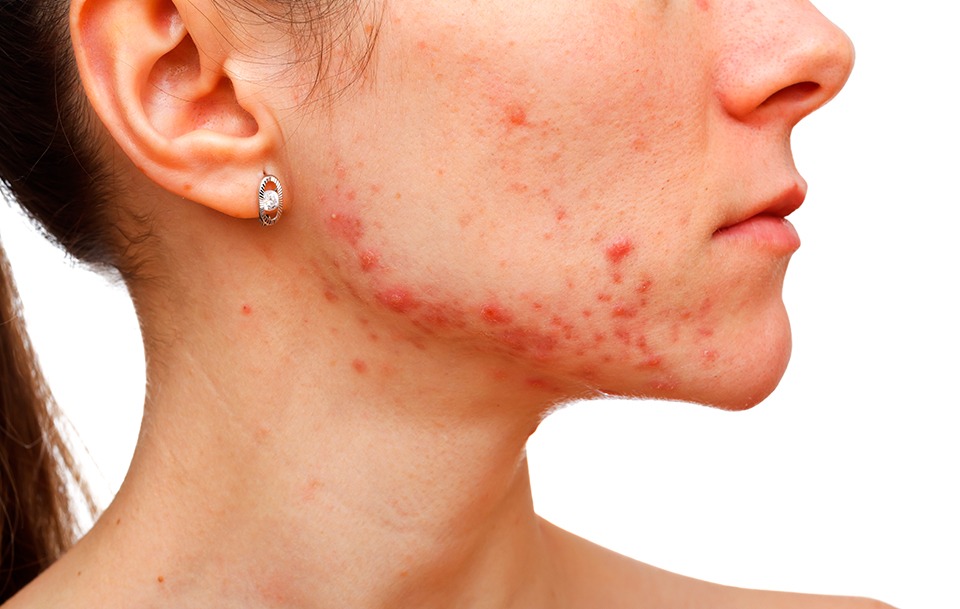Acne
The acne is the most prevalent cutaneous disorder in the population, as it can affect up to 80% of people at some point in their lives. The time of life where acne is most common is the adolescence and especially in men, and this is because androgens (hormones that have a peak in this period) stimulate the production of cutaneous sebum and this may end up obstructing the ducts of the sebaceous glands. This obstruction translates clinically with the appearance of comedones (comedones), which are the basic sign of acne and the first point from which it can become the cascade that leads to the inflammatory lesions of this disorder (papules and pustules), called Popularly as “pimples”.
Other factors that play a role in the origin of acne are bacterial overgrowth of a microorganism that coexists with us in the skin (Propionibacterium acnes) and personal and genetic tendency we have in the formation of comedones.
Interestingly, other factors that have very little role – despite their popularity – are skin hygiene and food. No scientific study has shown that washing your face more often or using specific hygiene products produces a clear improvement of acne. Likewise, as far as food is concerned, it is only necessary to bear in mind that an excess of fast absorption sugars (chocolate, sweets, unnatural fruit juices, pastries …) in a small period of time can facilitate the appearance or worsening of the acne. Moreover, the diet of the patient with acne should not be exclusive of any food (sausages, nuts …), since no efficacy has been proven on the evolution of the lesions.
Medical treatment of acne is directed to impact the factors that cause it:
- Excess sebum secretion: the retinols, derivative of vitamin A, of topical administration (tretinoin, adapalen) or oral (isotretinoin) are the most effective medications for acne, as impinging on the first step that generates the disorder: sebum secretion. In fact, oral retinols are the only drugs that allow definitively cure acne. Both cream and pills are a safe treatment that offers excellent results.
- Bacterial infection: Those acnes that have a lot inflammatory component or pustular can benefit from taking courses of topical or oral antibiotics, which produce a very rapid but temporary improvement of the “pimples”.
- Inflammation: The papules (red pimples) translate an inflammatory response. A therapeutic option for those acnes with very inflammatory component is to use topical anti-inflammatory (benzoyl peroxide, indomethacin, nicotinamide).
- Excess androgens: Those acnes that depend on an excess of male hormones (more common in women), require hormonal treatment, either with oral contraceptives or with oral antiandrogens.
Adolescent acne, despite being the most common skin disorder, has a complexity originally that reflected in their therapeutical options. However, with proper treatment according to each case it can be resolved completely and avoid possible consequences that may occur as marks or acne scars (for more information click here – send page laser therapy acne marks).
Adolescence in middle age
Although during the adolescence it is more frequent in men, from 25 years the incidence is higher in women. This is because, not infrequently, acne can be a marker of hormonal imbalance (polycystic ovarian syndrome or other hyperandrogenism) or misuse of usual cosmetics (for example, rose hip oil, tea tree, or fatty makeups).
Usually, the acne of the adult woman is often remarkably inflammatory (papules, pustules and painful nodules) and located in the lower third of the face, with possibility of also affect the cervical area.
In the diagnostic algorithm of women’s acne, it is paramount to make clinical history about the patient’s cosmetic habits, emphasizing on the use of fatty substances. Likewise, the second step is the investigation of menstrual rhythm and other manifestations that may accompany an excess of male hormones -hyperandrogenisme- (hair loss, excess hair, seborrheic skin …). It is usual for, in a persistent acne in an adult woman, a dermatologist to ask for a hormonal analysis that will be performed during the days of menstruation to study the patient’s androgen profile: this will make it possible to rule out or confirm if there is an endocrinological disruption. In these cases, acne is only an external manifestation of a hormonal disorder, and the treatment of these patients consists in to readjust the hormonal levels, not just for the acne disappears, but also (and mainly) to improve the endocrinological and metabolic profile.
This approach is essential to find the cause of acne and treat it. Contrarily, if it does not study the origin, it is possible that, initially, the acne responds satisfactorily but that upon cessation of treatment, there is a relapse, as the underlying cause will continue to stimulate the production of cutaneous sebum. In fact, it is possible to suspect an endocrine disorder in a woman when the treatment of acne fails repeatedly.
As for the acne treatment of women, it will depend on the cause. If it is an external manifestation of a hormonal disorder, it is possible to opt for oral contraceptives or non-contraceptive antiandrogens, such as flutamide or spironolactone. If it corresponds to an acne without an endocrinological background, the oral vitamin A derivatives are usually solve it.
Videos

